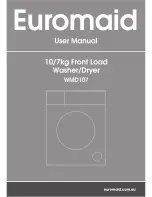
10
Lipstick:
moisten with acetone as above, then treat
stains with methylated spirits. Remove any residual
marks from white fabrics with bleach.
Red wine:
soak in water and detergent, rinse and
treat with acetic or citric acid, then rinse. Treat any
residual marks with bleach.
Ink:
depending on the type of ink, moisten the fabric
first with acetone (*), then with acetic acid; treat any
residual marks on white fabrics with bleach and then
rinse thoroughly.
Tar stains:
first treat with stain remover, methylated
spirits or benzine, then rub with detergent paste.
(*) do not use acetone on artificial silk
Detergents and additives
Good washing results also depend on the choice of
detergent and use of the correct quantities to avoid
waste and protect the environment. Although
biodegradable, detergents contain substances which,
in large quantities, can upset the delicate balance of
nature.
The choice of detergent will depend on the type of
fabric (delicates, woollens, cottons, etc.), the colour,
washing temperature and degree of soiling.
All commonly available washing machine detergents
may be used in this appliance:
– powder detergents for all types of fabric,
– powder detergents for delicate fabrics (60°C max)
and woollens,
– liquid detergents, preferably for low temperature
wash programmes (60°C max) for all types of
fabric, or special for woollens only.
The detergent and any additives must be placed in
the appropriate compartments of the dispenser
drawer before starting the wash programme.
If using concentrated powder or liquid detergents, a
programme
without
prewash must be selected.
Pour liquid detergent into the dispenser drawer
compartment marked
just before
starting the
programme.
Any fabric softener or starching additives must be
poured into the compartment marked
before
starting the wash programme.
Follow the product manufacturer’s recommendations
on quantities to use.
Quantity of detergent to be used
The type and quantity of detergent will depend on the
type of fabric, load size, degree of soiling and
hardness of the water used.
Water hardness is classified in so-called “degrees” of
hardness. Information on hardness of the water in
your area can be obtained from the relevant water
supply company, or from your local authority.
Follow the product manufacturers’ instructions on
quantities to use.
Use less detergent if:
– you are washing a small load
– the laundry is lightly soiled
– large amounts of foam form during washing.
132995750 EW859F gb.qxd 4/3/02 3:49 PM Pagina 10 (Nero/Process Black pellicola)
Содержание EW 859 F
Страница 1: ......




































